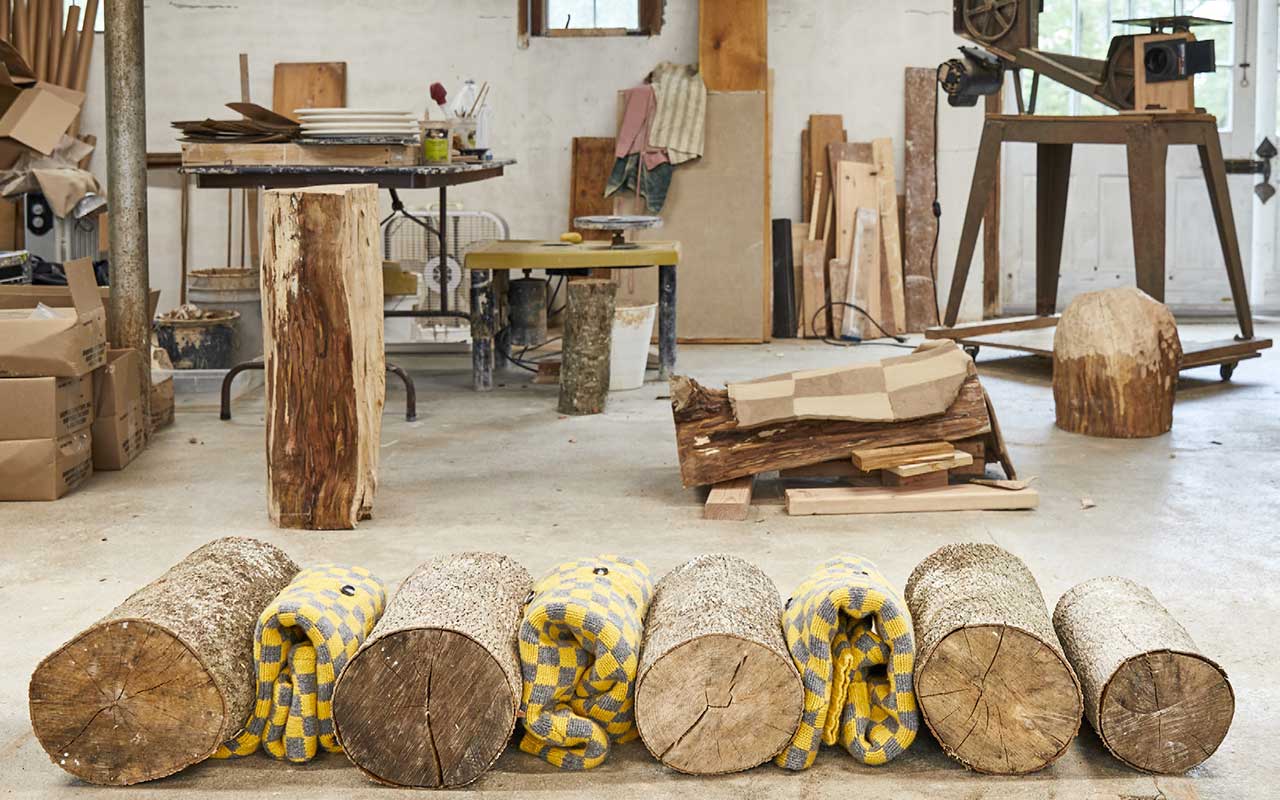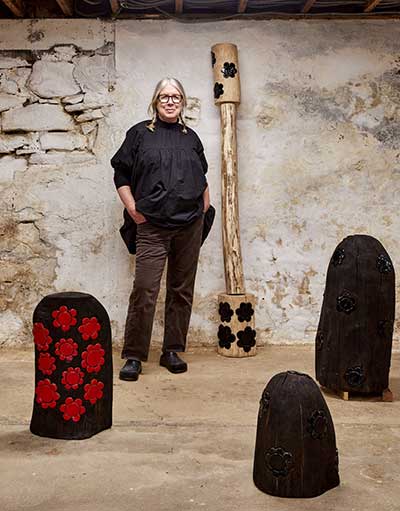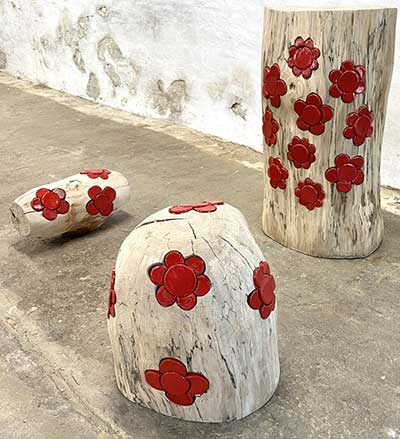Featured Artist

Finding Symbiosis Between Opposing Forces
“Working between printmaking, ceramic, wood, and textile, Janis Stemmermann employs craft processes in the creation of environments that interrogate links between media – and the fundamental, primal forces that unite them.” –Julia Silverman
I first became familiar with artist, printmaker, and designer Janis Stemmermann’s work when I saw her exhibition, Cut to Length, at Furnace – Art on Paper Archive, in Falls Village, CT. The exhibition included prints, woodwork, vessels and sculptures, often created by juxtaposing natural and man-made mediums: a stump enveloped by a bark-printed vessel, a block of firewood inlaid with ceramic, tree grain pattern prints on paper.
 Because I am a linear thinker who gets nervous when things aren’t in clearly defined categories, Stemmerman’s work gave me pause. What kind of artist was she? Where in a home was someone supposed to put a tree bark-printed vessel? Yet the work, emanating with green, cream, and light and dark browns, evoked feelings of calm, balance, and geometric fluidity.
Because I am a linear thinker who gets nervous when things aren’t in clearly defined categories, Stemmerman’s work gave me pause. What kind of artist was she? Where in a home was someone supposed to put a tree bark-printed vessel? Yet the work, emanating with green, cream, and light and dark browns, evoked feelings of calm, balance, and geometric fluidity.
As people, especially those who live dual lives between New York City and the Hudson Valley, Litchfield Hills, or the Berkshires, we tend to think of the time we spend indoors as distinctly separate from the time we spend in nature. Stemmermann challenges this idea, and the idea of siloing altogether, to demonstrate that as much as we might like to have distinct spaces, vocations, and identities, interconnection and relationships, no matter how unclear or messy they may be, are unavoidable and in fact more innate than we realize. Stemmermann even takes this idea a step further insofar as her process itself is often an intentional collaboration with artists possessing different skill sets. Finding symbiosis between opposing forces is precisely what she is interested in, and the resulting work embodies the outgrowth of that cooperation.
Tell us about yourself.
I was born in Neptune, NJ, as the youngest of four. I had a very good early childhood – we took a few epic family camping trips across the country, my mom threw great Halloween parties, and my parents encouraged all my creative interests. I’m really the same person today as I was growing up because I was always making my own clothes, painting something, taking things apart, and putting them back together.
My father had been a marine during WWII, and he was extremely patriotic. He was part of the 1970s “back to the land” movement. When I was ten, my parents bought land in New Hampshire, near where my mother had been raised and where her parents still lived. In 1973, on a summer vacation, my father put in a foundation for a log cabin that we were going to build on the land as a family project. When we were about to return home, he had a massive stroke and died three days later, he was just 47.
The following summer, my mother took us back to New Hampshire, and we built the log cabin my father intended. She ordered the log cabin kit from Vermont – the most basic one where they just give you the logs, but you had to strip the bark, make the notches, and build the cabin yourself. It was truly a visceral experience of the landscape and what it means to build something, and especially as it was attached to this really sad story. Retrospectively I realize my artistic work started there. I wasn’t conscious of it until later, but I was always really interested in making things and transforming materials.
I went to the University of New Hampshire, where the art department was very traditional. But I also took photography classes with an amazing professor who allowed me to be very experimental. He encouraged me to leave UNH and go to art school. I took his advice and transferred to the Maryland Institute College of Art. The foundation year there really changed my perspective – it introduced me to the contemporary work of the time, conceptual art, and feminist art. Information was presented in a way that was not about academia or about knowing how to render; it was more about ideas and life and living in the world.
The other thing that happened in the first semester of art school was that my oldest brother was killed in a plane crash. Ten years after my father died, my brother was killed. As a salve to the difficult time, I submerged myself in the studio work. I started to get noticed and received encouragement and support for what I was making. That’s when I started tapping into these experiences of handling materials and larger pieces, unconsciously tapping into these places within me that I wanted to hold onto physically.
How did your career develop?
After graduating art school I moved to New York City and got a job as an assistant to master printmaker, Catherine Mosley, which was where I learned printmaking. The primary work we did was printing Robert Motherwell’s etchings. When Motherwell passed away in 1991, I was living in Brooklyn and decided to buy my own press. I opened it up as a collaborative press to work with other artists.
 I was making my own work, but I decided printmaking was going to be my vocation – at the time it seemed to be a viable way to make a living. But then in the early 1990s the art market crashed, and the print market became more difficult. I continued to work with a few artists on a regular basis as well as self-publishing projects. That’s when I started focusing on my sculpture, and things started to accelerate with my own work, I attended residencies, received some grants, and started showing in non-profit spaces.
I was making my own work, but I decided printmaking was going to be my vocation – at the time it seemed to be a viable way to make a living. But then in the early 1990s the art market crashed, and the print market became more difficult. I continued to work with a few artists on a regular basis as well as self-publishing projects. That’s when I started focusing on my sculpture, and things started to accelerate with my own work, I attended residencies, received some grants, and started showing in non-profit spaces.
I met my future husband, and we had our first child. I had always knit for myself, and I began knitting with our babysitter. Creating designs influenced by my artwork, I started a company called Brooklyn Handknit that I operated for ten years. We had two retail stores, we sold globally to Saks and Bergdorf’s, and we had 45 hand knitters at one point. As the business took over, I stopped my own sculpture work, I wasn’t a frustrated artist though, the craft part was always an informed part of Brooklyn Handknit.
I became known in the fashion industry, and then in the 90s there was a knitting resurgence, and I was on the front end of it. Even though I wasn’t trained as a designer, I had a strong point of view. Eventually I was offered a job as a design director in a corporate fashion company – I was the person who was creative but also understood the business side. I really had to be in touch with and use both sides of my brain.
What is Russell Janis?
In 2013 when our children were older, ideas started occupying my mind again, and I really wanted to get back to my art. At the same time, my husband and I decided to start Russell Janis, a platform where we “facilitate and exhibit projects with invited artists across disciplines.” By curating projects, inviting artists to come make prints, and exhibiting works, we created a community. To get back to my own work, I started working in clay in a shared ceramic studio and attended an artists’ residency. Buying the property in Sharon, CT, was really part of that process because I wanted to get a bigger studio to have my own kiln and make larger works. And I wanted to have a relationship with the landscape again, which was really important in my earlier work.
What is your process?
I’ve been an artist, a printmaker, and a designer. Right now I’m everything all at once. My approach is to have parallel practices that overlap and inform each other. It’s hard for me to stay siloed in one discipline. That’s not really how I think, and my interests take me in many directions. I think we are naturally more multi-disciplinary than we acknowledge.
In my studio practice, my focus is on making objects because I am interested in the physical world we live in. As I try to navigate an element that is interesting to me, the objects themselves teach me about how they exist and relate within an installation. When I first started doing ceramics, I was making functional pieces, and then a while back my husband said, “Why don’t you just stop making functional pieces?”
I’m always testing things and experimenting so that when it comes time to manifest, I have more information. Often the most interesting things come from the playfulness in that process and responding to what’s happening in front of me. In the design part, I really look aesthetically at how materials and forms come together. In I am always surprised by the results: you really don’t know what a piece is going to look like until it’s actually made.
How have you combined natural and domestic materials?
Arriving in Sharon in 2019, we had to cut trees down as well as deal with fallen trees on the untended property. As we cut them for firewood, I saved large sections as well as young maples that had been cut from the stone walls. In time I began to bring the wood into the studio and incorporate it into my work. I am always thinking about influences of domestic spaces as well as elements of the landscape. There’s this tension. I like to combine two opposing ideas and see if I can make the piece work. For example, in some recent sculptures I made decorative ceramic flower tiles and inlaid them into shaped tree stumps. The results visually collapse the context of each element together.
How does collaboration factor into your work?
Engagement is very important to me. I like to work in a way that’s visceral and connective. Being trained as a collaborative printmaker, I have the ability to facilitate the creative process in someone else’s work. I have done several collaborations with my friend Louise Eastman, who is very playful and organic. Working together loosens me up. I’m always learning from her what is possible. You can’t control the outcome, but you both bring good ingredients to the table, and that’s what you go with. Collaboration, interconnection, we aren’t siloed. Exciting things come from opening up and having a more integrative approach. •
Janis Stemmermann’s sculptures and textiles are included in Talkshop 3.0 Verse Workshop in Red Hook, NY, through December 23. You can learn more at janisstemmermann.com and at russelljanis.com.
